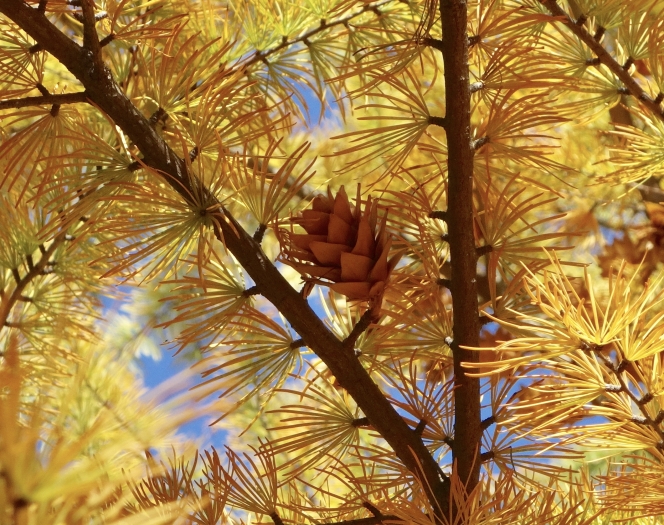Chinese Golden-Larch
(Pseudolarix amabilis)
Chinese Golden-Larch (Pseudolarix amabilis)
/
/

William (Ned) Friedman
CC BY-SA 4.0
Image By:
William (Ned) Friedman
Recorded By:
Copyright:
CC BY-SA 4.0
Copyright Notice:
Photo by: William (Ned) Friedman | License Type: CC BY-SA 4.0 | License URL: https://creativecommons.org/licenses/by-sa/4.0 | Uploader: Akgarb | Publisher: Wikimedia Commons | Title: Pseudolarix_amabilis_in_fall.jpg | Notes: Guava fruit bought and photographed in Taiwan on 20 January, 2004. Binomial name is tentative. |
































Estimated Native Range
Summary
Pseudolarix amabilis, commonly known as Chinese Golden-Larch, is a deciduous conifer native to mountainous regions and forest valleys in Southeastern China. It typically grows to a height of 30-60 feet (9-18 meters) and a width of 20-40 feet (6-12 meters). The tree is notable for its pyramidal form when young, becoming more broadly conical with age. The needles turn a brilliant golden yellow before they shed in the fall, which is a highly valued ornamental feature. The tree produces small, non-showy cones. Chinese Golden-Larch is appreciated for its bright fall foliage and its adaptability to summer heat and humidity, which allows it to thrive in regions where other larches may struggle.
In cultivation, Chinese Golden-Larch is used as a specimen tree in parks and large gardens. It requires full sun to develop its best form and color but can tolerate partial shade. It prefers medium amounts of water and well-drained soils. While it is tolerant of summer heat and humidity, it is less successful in cooler climates with mild summers, such as the United Kingdom. The tree has been awarded the Royal Horticultural Society’s Award of Garden Merit, indicating its value in garden settings. Care should be taken when planting this tree in urban areas, as it requires space to accommodate its size at maturity.CC BY-SA 4.0
In cultivation, Chinese Golden-Larch is used as a specimen tree in parks and large gardens. It requires full sun to develop its best form and color but can tolerate partial shade. It prefers medium amounts of water and well-drained soils. While it is tolerant of summer heat and humidity, it is less successful in cooler climates with mild summers, such as the United Kingdom. The tree has been awarded the Royal Horticultural Society’s Award of Garden Merit, indicating its value in garden settings. Care should be taken when planting this tree in urban areas, as it requires space to accommodate its size at maturity.CC BY-SA 4.0
Plant Description
- Plant Type: Tree
- Height: 30-60 feet
- Width: 20-40 feet
- Growth Rate: Slow
- Flower Color: N/A
- Flowering Season: Non-Flowering
- Leaf Retention: Deciduous
Growth Requirements
- Sun: Full Sun
- Water: Medium
- Drainage: Medium
Common Uses
Deer Resistant, Low Maintenance
Natural Habitat
Mountainous regions and forest valleys in Southeastern China
Other Names
Common Names: Golden-Larch, Japanese-Larch, Chinese Golden Larch, Golden Larch, Chinesische Goldlärche, Goldlärche, Faux Mélèze De Kaempfer, Álvörösfenyo, Лжелиственица Кемпфера, Guldlärk
Scientific Names: , Pseudolarix amabilis, Larix amabilis, Pseudolarix kaempferi, Pseudolarix pourtetii, Chrysolarix amabilis, Laricopsis fortunei, Laricopsis kaempferi, Pseudolarix fortunei,
GBIF Accepted Name: Pseudolarix amabilis (J.Nelson) Rehd.